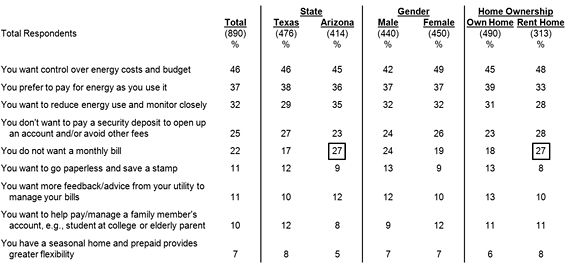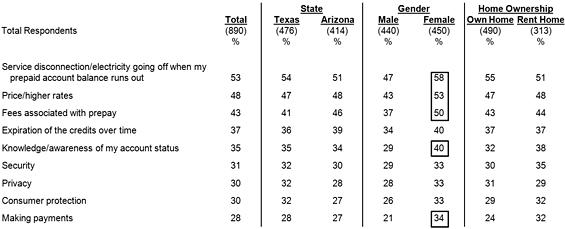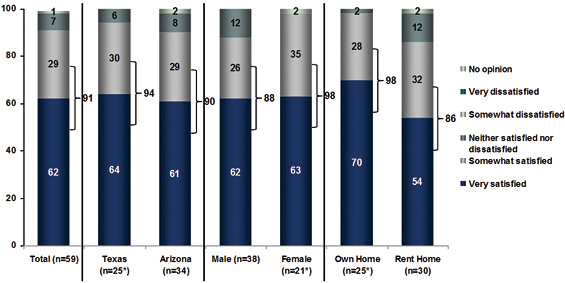EcoAlign is a strategic marketing agency focused on energy and the environment. DEFG LLC is a specialized management consulting firm in the energy space. In November 2011, the two firms partnered to conduct approximately 900 online interviews to test customer awareness and acceptance of prepay electricity offerings in Texas and Arizona,1 the two states with the largest base of U.S. consumers currently on a prepay electricity plan. The EcoAlign-DEFG team worked with the members of the Prepay Energy Working Group2 to finalize the survey instrument, and research for the survey was conducted by Russell Research.
DEFG’s Prepay Energy Working Group – now in its third consecutive year – has researched trends and levels of consumer satisfaction across different prepay industries. In late 2010, a national consumer survey was conducted to test perceptions and expectations related to a variety of prepay services and products, and to examine the potential for voluntary prepay electricity options offered by local utilities.3
One objective of the latest survey conducted in Texas and Arizona was to revisit trends and levels of consumer satisfaction across different prepay industries. Even more important, however, was an effort to gain insight around consumer awareness and acceptance of prepay electricity service. Survey questions explored actual or perceived benefits, concerns and expectations tied to prepay electricity.
Survey Findings
The 2010 national survey revealed prepay as an option for a variety of products and services that had in fact become mainstream. Americans were increasingly using prepay in many forms, such as reloadable debit cards, transit cards, healthcare, wireless service plans, etc., and they were satisfied. Moreover, once consumers used a form of prepay, they were likely to continue using it, to try it for other services/products, and to recommend it to family and friends. The survey discovered “ease” and “convenience” to be the drivers behind customer satisfaction with various prepay options.
The latest results from Texas and Arizona point to consumers strongly correlating prepay electricity with increased control and management, and the potential to use less energy and save money. Nearly all U.S. energy consumers currently receive an energy bill at the end of the month with no real or temporal linkage between consumptive behavior and cost. Prepay electricity enabled by smart grid is a billing option with the potential for a consistent feedback loop delivered via SMS, email, web, in-home display, or possibly a combination of these channels.
The consistent information flow provides consumers the opportunity to monitor their usage and credit balance, thus linking dollars and energy usage in close-to-real-time. Prepay service providers have in fact realized an energy consumption impact, with Salt River Project in Arizona reporting an average decrease in usage of 12 percent per household.4
While still a nascent offering in most U.S. jurisdictions, prepay electricity shows promise for high satisfaction among the consumers that choose it. The top line findings include:
- The top reasons consumers would enroll in a prepay electric service plan are: “control over energy costs and budget” (46 percent), “prefer to pay for energy as you use it” (37 percent), and “want to reduce energy use and monitor closely” (32 percent)

Top Two Reasons Would Choose or Have Chosen to Enroll in Prepay Electric Service Plan5
- Consumers think the most important features of a prepay electric service plan are: “using less energy and saving money” (33 percent), “avoiding fees” (25 percent) and “helps manage my budget better” (24 percent)
- When asked for one word to describe prepay electric service, “convenient” was mentioned the most by far. Other terms mentioned at lower levels were: “interesting,” “easy” and “savings”

Provide One Word To Describe “Prepaid Electric Service”6
- When asked for one word to describe the biggest concern regarding prepay electric service, the most frequently-mentioned were: “cost,” “price,” “overpaying” and “expensive.” At slightly lower levels, consumers mentioned: “money,” “unknown,” “reliability,” “running out,” “usage” and “budget”
- When asked to rate their concerns using a ten-point scale, consumers applied a “9” or “10” (representing extreme concern) to the following: “service disconnect/electricity going off when my prepay account balance runs out” (53 percent); “price/higher rates” (48 percent); “fees associated with prepay” (43 percent); “expiration of credits over time” (37 percent); and “knowledge/awareness of my account status” (35 percent).

Specific Concern regarding Prepaid Electricity Service
(applied a “9” or “10” which represents extreme concern to the following)7
- One half of the respondents do not know whether prepay or post-pay energy costs more, and one fifth think prepay energy is more expensive
- When the respondents were asked what types of consumers may benefit from a prepay electric option, 18 percent thought it was best suited for low-income consumers, but 27 percent thought it would benefit all the consumer segments that were listed (i.e., renters, seniors on a fixed income, young people 18–30 years old, among others)
- As noted earlier, Texas and Arizona were chosen as the focus of this consumer survey because they are the states with the greatest number of consumers currently on a prepay electricity plan. Responses reveal both states to still be in the early stages of adoption, with 7 percent of respondents in Texas and 10 percent in Arizona indicating they currently receive prepay electricity service 8
Admittedly a small base of respondents, but nearly all of the current prepay customers are satisfied with their current prepay electric service:
- More than half (62 percent) indicated being “very satisfied,” while an additional 29 percent are “somewhat satisfied” (totaling 91 percent)
- When asked if they were likely to recommend prepay electric service to family and friends, 63 percent are “very likely” to recommend, while additional 25 percent are “somewhat likely” (totaling 88 percent)
- These numbers are nearly identical

Satisfaction Rating of Prepay Electricity Service9
What Does It All Mean?
The findings show that the trend towards prepay products and services continues to intensify, with approximately two thirds of consumers in Texas and Arizona having used some type of prepay method in the recent past, in particular reloadable debit cards, gift cards, and/or wireless services. Prepay as a bill payment option or alternative means to transact business is clearly used and accepted by a majority of Americans regardless of income.
What is behind the trend? Why are consumers satisfied with prepay options? Leading drivers for customer satisfaction with various prepay products and services are convenience and ease. Similarly, the perceived attributes of prepay electric service and top reasons to sign up for prepay electric service in both the 2010 survey and the latest survey were convenience and control over costs and energy usage. These drivers are directly related to lifestyle, budget and bill payment preferences.
Consumer segments that will be interested in prepay service will have different sets of motivations and expectations. The ability to pay for electricity in any amount (small or large increments) at a selected time via a preferred channel (e.g., mobile, online, or pay center at a local supermarket) will be valued by a certain segment of customers over a one-time lump sum monthly bill.
Perhaps more affluent “snowbirds” might like the ability to pay in advance for several months and receive regular updates with usage data for a home they left vacant, or possibly even “self disconnect” (i.e., purposely allow credit to run to zero, prompting a disconnect) for an extended period without the hassle of late payment penalties and the reconnect process typical for post-pay service.
An interesting finding is the potential willingness of 88 percent of current prepay electric consumers to recommend the service to their families and friends. While an admittedly small sample, the finding indicates high satisfaction and also points to these customers having trust in the potential for benefits to be shared by a certain segment of their family and friends network. This impact can be employed as a customer satisfaction metric referred to as “net promoter score,” which over the last few years has garnered greater significance with increased communication via mobile lifestyles and social media.
Prepay electricity is a voluntary option that will be preferred and valued by certain segments of customers, but not by others. An offering such as prepay electricity – and other options enabled by smart grid – mandates a more nuanced, segmented view of the marketplace that goes well beyond the “ratepayer” construct where everyone is treated the same regardless of personal preferences.
Recommendations
PREPAID ELECTRICITY POWERS A SHIFT IN CONSUMER BEHAVIOR
Direct Energy spearheads interactive approach to electricity in Texas…
If there is one thing that customers truly cherish these days, its convenience. In today’s fast-paced world, consumers need timely information especially as it relates to helping them manage their energy consumption.
Direct Energy’s prepaid product is a pay-as-you-go plan with no deposit fees that offers customers convenience, control and cost savings on their energy bills. With the prepaid electricity plan Direct Energy sends a text or email daily to customers alerting them of their electricity usage, how much they spent the previous day and their current account balance, giving customers the information they need, when they need it, so they can make necessary lifestyle changes.
“Direct Energy’s prepaid service is designed to give people control over their electricity bills,” said Jim Steffes, vice president and general manager for Direct Energy. “With quick, easy access to their energy usage information, customers can take some easy steps to reduce costs by reducing usage.”
As customers are becoming more aware of their daily usage, they are better able to manage their energy bill. “My prepaid electricity has been running $25 to $30 a month, whereas my bill used to be somewhere between $100 and $180,” said Marilyn, a prepaid customer.
Not only does prepaid provide cost savings to customers, but it encourages customers to be more conscious of the environmental impact of those changes– last summer prepaid customers used 14% less peak energy. This proves that prepaid electricity is not just a new way to pay for electricity; it’s a fundamental shift in the customer experience around electricity consumption.
Direct Energy was the first of the three largest retail electric providers in Texas to offer consumers the choice of a hassle-free way to pay for their electricity, as and when they need it. Consumers now can be in control – simply by paying for what they use and the flexibility to pay for more electricity when it meets their needs.
“With pay-as-you-go, you know each day what you spend. You can remember what you did yesterday versus what you did a month ago,” said Tonie a prepaid customer. “I love the program. I’ve recommended it to my father, two of my coworkers and my best friend.” This level of consumer interest helps to explain how prepaid has achieved a 16 percent monthly compounded growth rate in 2011.
Today, Direct Energy is the prepaid leader in Texas’ competitive electricity market and is now seeking to partner with other utilities – both public and investor-owned - to share its lessons, systems and approach for prepaid solutions for consumers across the US.
With a line of sight to customer satisfaction and benefits for certain segments of consumers that will opt for prepay electric service, the DEFG-EcoAlign team makes the following recommendations:
- Research: There is a need for more research to identify and better understand the segments of customers that are going to like prepay electricity, and the different motivations and expectations for each segment.
- Satisfaction and Benefits: Perceived benefits of prepay electricity include: using less energy and saving money, increased budget control, convenience, no security deposit and late fees, and no monthly bill. Indeed, prepay can meet expectations around improved cash management in a number of ways. For instance, the nature of prepay is incremental compared to traditional monthly billing. As more consumers, especially younger adults, increasingly conduct financial transactions via smart phone, there is an opportunity for consumers to make payments wherever, whenever, and in an amount that best suits them. More frequent payments in smaller amounts align nicely with a mobile lifestyle.
- Messaging: With different segments identified, a provider can market to customers in a manner (via preferred communication channel) and with content that aligns with their motivations and expectations (e.g., explain why prepay provides additional budget control).
- Education: Prepay electricity is a bill pay option, but also a very different way of buying and using electricity that changes the relationship between the provider and the customer. Education on how prepay works is important. Over time, with substantial analysis and data of actual use, consumers would appreciate predictive recommendations to help them optimize their use of the service.
- Transparency: There is real uncertainty regarding the price of prepay electric service and concern regarding the possibility of service disconnect / electricity being turned off. Service providers must be transparent to dispel confusion—the basis for pricing and the applicable policies and protections for service disconnection must be clearly addressed.
- Potential for Energy Management and Pricing Options: Results point to consumers making a strong correlation between prepay electric service and using less energy and saving money. Prepay should be viewed as a platform for energy management and other pricing options.
Prepay could be viewed as a daily bill pay conservation that is transactional (dollars and cents), relevant (focused on saving energy to manage bills), and actionable (today’s information could result in impacts on tomorrow’s conversation). As part of the conservation, consumers would be open to receiving relevant and actionable information such as rebate details, different pricing options and energy assistance.
The facts show real potential for a substantial consumer base to use and value prepay electric service. Prepay service, however, is often framed as a low-income option within the utility sector. As many low-income consumers value the option to better manage their cash/credit, so too would other consumer segments. The key is to identify them.
About the Author
 Cindy Boland O’Dwyer is a Vice President with DEFG LLC, a specialized management consulting firm in the energy sector, and a lawyer with LEED G.A. Certification, the U.S. Green Building Council’s Leadership in Energy and Environmental Design Green Associate designation. Ms. O’Dwyer leads DEFG’s Prepay Energy Working Group and activities in legal and regulatory matters.
Cindy Boland O’Dwyer is a Vice President with DEFG LLC, a specialized management consulting firm in the energy sector, and a lawyer with LEED G.A. Certification, the U.S. Green Building Council’s Leadership in Energy and Environmental Design Green Associate designation. Ms. O’Dwyer leads DEFG’s Prepay Energy Working Group and activities in legal and regulatory matters.
1 Prepay electricity service, or a “pay-as-you-go” option offered by a utility or energy supplier, would be voluntary and require the customer to prepay or pay upfront for electricity before using the service.
2 The Prepay Energy Working Group is managed by DEFG LLC and consists of market participants (utilities, energy retailers, metering and software vendors) and a pro-bono advisory panel of regulators and consumer advocates. Member interacts on a regular basis, and all research efforts and deliverables are put through an iterative process and thoughtful discussion prior to public release.
3 The results and key findings from the national survey were shared in EcoPinion Survey Report No. 9, “Is Prepay the Way? Consumer Perceptions of Prepay in the Utility Sector.”
4 Paying Upfront: A Review of Salt River Project’s M-Power Prepaid Program. EPRI, Palo Alto, CA: 2010. 1020260.
5 Question 10: Which of the following are the top two reasons that you and your family would choose or have chosen to enroll in a prepaid electric service plan?
6 Question 16: What one word would you use to describe prepaid electric service? Please be as specific as possible.
7 Question 18: When considering prepaid electric service, how concerned would you say you are when thinking about each of the following? Please use a scale from 1 to 10, with 10 being Extremely Concerned and 1 being Not Concerned At All.
8 The total number of consumers enrolled in a prepay electric plan in Texas and Arizona is currently in the hundreds of thousands, which is still substantial and also ripe for growth.
9 Question 6: How would you generally rate your satisfaction with your prepaid electricity service? (Caution, small base size: total currently enrolled in prepaid electricity plan.)







